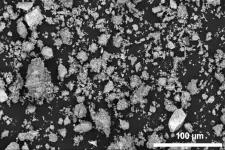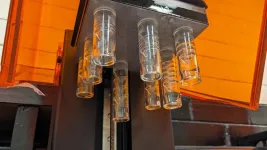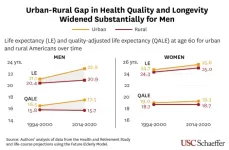Now we know why children with Down’s syndrome have higher risk of Leukemia
2024-09-25
(Press-News.org)
People with Down’s syndrome face a higher risk of developing Leukemia. Now researchers from the University of Copenhagen and Stanford University explain why, by identifying specific changes in blood cells of people with Down’s syndrome.
In the world, one out of 700 children are born with Down’s syndrome. A syndrome, where the child has an extra copy of chromosome 21, resulting in 47 chromosomes instead of 46. This typically results in characteristic physical features and some level of learning disability.
But newborns with Downs syndrome also tend to have an elevated number of red blood cells, and as they grow older, they face a 150-fold higher risk of developing leukemia compared to those without the condition.
“Our study revealed that the additional chromosome 21 alters how DNA is packed inside the cells. This difference affects how certain genes are regulated and can contribute to the development of leukemia,” explains Rebecca Moller, one of the researchers from University of Copenhagen behind the new study.
To more precisely understand the impact of the extra chromosome 21, the researchers sequenced the genes of over 1.1 million cells from fetuses with and without Down’s syndrome.
“Interestingly, the dysregulations are not uniform and vary depending on the cell type and its environment. We found for example that blood stem cells in individuals with Down’s syndrome show dysregulations of genes involved in making red blood cells, explaining the symptoms in newborns” says Professor Ana Cvejic, the senior lead scientist from University of Copenhagen.
Too many cellular “powerhouses”
The researchers also identified another crucial difference in the blood stem cells of people with Down’s syndrome: an increased number of mitochondria, the “powerhouses” of the cells that generate energy.
While energy production is vital, too many mitochondria can damage a cell and its DNA by producing harmful molecules.
“These harmful molecules, called reactive oxygen species, are known to attack DNA creating mutations that can lead to pre-leukemia and, eventually, leukemia.” explains Dr Andrew Marderstein, from Stanford University and the first author in the study.
The findings from the study underscore the importance of understanding the intricate relationship between genetics and the cellular environment of blood cells in individuals with Down’s Syndrome.
“This study is the largest of its kind, and it shows that the environment and genetic makeup of cells are crucial in understanding how blood cells and leukemia develop. Understanding these mechanisms is essential for guiding future research in stem cell biology and cancer,” says Professor Ana Cvejic, who emphasizes that these insights pave the way for a better comprehension of disease development in Down’s Syndrome.
The study 'Single-cell multi-omics map of human fetal blood in Down syndrome' has been published in Nature.
END
ELSE PRESS RELEASES FROM THIS DATE:
2024-09-25
About The Study: Treatment-emergent nirmatrelvir resistance mutations were commonly detected, especially in individuals who were immunosuppressed in this cohort study of 156 participants. However, these mutations were generally present at low frequencies and were transient in nature, suggesting a low risk for the spread of nirmatrelvir resistance in the community with the current variants and drug usage patterns.
Corresponding Author: To contact the corresponding author, Jonathan Z. Li, MD, MMsc, email jli@bwh.harvard.edu.
To access the embargoed study: Visit ...
2024-09-25
About The Study: In this study, semaglutide was associated with reduced opioid overdose risk in patients with comorbid type 2 diabetes and opioid use disorder, suggesting its potential therapeutic value for preventing overdoses. The results need validation from other data resources and study populations. Further research is warranted to investigate the underlying mechanisms and randomized clinical trials are necessary to corroborate the clinical effects on opioid use disorder.
Corresponding Authors: To contact the corresponding authors, email Rong Xu, PhD, (rxx@case.edu) ...
2024-09-25
Food fermentation is the oldest production practice using microorganisms in human history. Milk fermentation, for example, can be traced back to 6000–4000 BC in India, and Mediterranean populations produced and consumed cheese as early as 7000 before present (BP).
Despite the long history of human consumption of fermented products, though, little has been known about the history of the use of fermentative microorganisms and the history of related cultural transmission. In particular, the evolutionary trajectories, especially functional adaptation, of these ...
2024-09-25
Adults with opioid use disorder who receive a higher daily dose of the opioid addiction treatment medication buprenorphine may have a lower risk of subsequent emergency department visits or use of inpatient services related to behavioral health (such as for mental health and substance use disorders) than adults receiving the recommended dose, according to an analysis funded by the National Institutes of Health (NIH). These findings suggest that higher buprenorphine doses could be more effective in managing opioid use disorder, which may be particularly relevant for improving treatment for those who use fentanyl, a major ...
2024-09-25
With the climate pattern known as El Niño in full force from mid-2023 to mid-2024, global temperatures broke records for 12 months in a row. As one of the strongest El Niño events on record, it was likely the main culprit of unprecedented heat, floods and droughts worldwide.
In a new study published Sep. 25 in the journal Nature, a University of Colorado Boulder climate scientist and collaborators reveal that the planet could see more frequent extreme El Niño events by 2050 if greenhouse gas emissions continue to increase.
“It’s ...
2024-09-25
Imagine being one cartwheel away from changing your appearance. One flip, and your brunette locks are platinum blond. That’s not too far from what happens in some prokaryotes, or single-cell organisms, such as bacteria, that undergo something called inversions.
A study led by scientists at Stanford Medicine has shown that inversions, which cause a physical flip of a segment of DNA and change an organism’s genetic identity, can occur within a single gene, challenging a central dogma of biology — that one gene can code ...
2024-09-25
Gladstone Institutes has established a new scientific award, the Sobrato Prize in Neuroscience, to advance breakthroughs in brain research with high potential for patient impact—and announced it will present the inaugural prize to Yadong Huang, MD, PhD, a trailblazer in Alzheimer’s research.
In his nearly three decades at Gladstone, Huang has led a series of pioneering studies on the genetic underpinnings of Alzheimer’s disease, with discoveries that have opened multiple new avenues for drug development. He ...
2024-09-25
Rechargeable lithium-ion batteries are growing in adoption, used in devices like smartphones and laptops, electric vehicles, and energy storage systems. But supplies of nickel and cobalt commonly used in the cathodes of these batteries are limited. New research led by the Department of Energy’s Lawrence Berkeley National Laboratory (Berkeley Lab) opens up a potential low-cost, safe alternative in manganese, the fifth most abundant metal in the Earth’s crust.
Researchers showed that manganese can be effectively used in emerging cathode materials called disordered rock salts, or DRX. Previous research suggested that to perform well, DRX materials had to be ground down to nanosized ...
2024-09-25
Link to Google Drive folder containing images:
https://drive.google.com/drive/folders/1ZTBXkIFqwl_OyIMrUA1se_iv7hqEm_52?usp=sharing
Link to release:
https://www.washington.edu/news/2024/09/25/tesla-coil-shark-intestines/
FROM: James Urton
University of Washington
206-543-2580
jurton@uw.edu
(Note: researcher contact information at the end)
For immediate release
Sept. 25, 2024
To make fluid flow in one direction down a pipe, it helps to be a shark
Flaps perform essential jobs. From pumping hearts to revving engines, flaps help fluid flow in one direction. ...
2024-09-25
Rural men are dying earlier than their urban counterparts, and they’re spending fewer of their later years in good health, according to new research from the USC Schaeffer Center for Health Policy & Economics.
Higher rates of smoking, obesity and cardiovascular conditions among rural men are helping fuel a rural-urban divide in illness, and this gap has grown over time, according to the study published this week in the Journal of Rural Health. The findings suggest that by the time rural men reach age 60, there are limited opportunities to fully address this disparity, and earlier interventions may be needed to prevent it from widening ...
LAST 30 PRESS RELEASES:
[Press-News.org] Now we know why children with Down’s syndrome have higher risk of Leukemia




